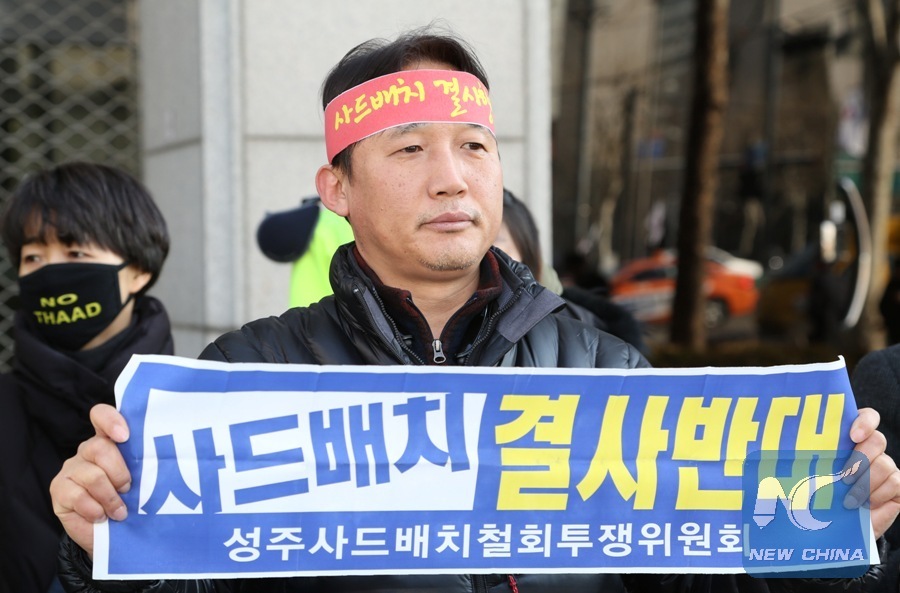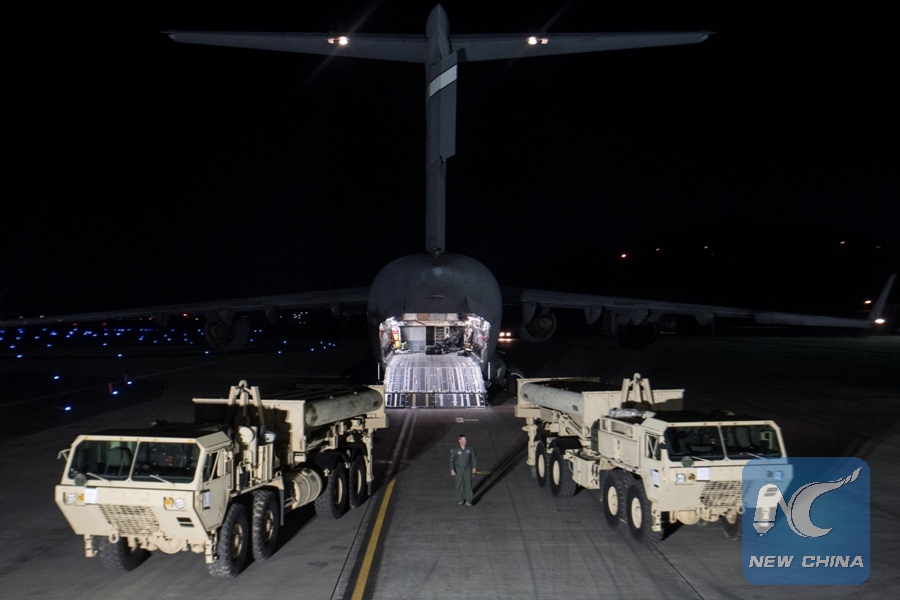
A man protests against the deployment of an advanced U.S. missile defense system in front of the Lotte Headquarters in Seoul, South Korea, Feb. 27, 2017. (Xinhua/Lee Sang-ho)
SEOUL, March 7 (Xinhua) -- South Korea has hurriedly launched the process of deploying a U.S. missile shield to its soil despite continued, repeated oppositions from neighboring countries and residents.
The defense ministry Tuesday said two mobile launchers and part of equipments necessary for Terminal High Altitude Area Defense (THAAD) installation arrived in the Osan Air Base, about 70 km south of capital Seoul, at Monday night.
THAAD is composed of six mobile launchers, 48 interceptors, one X-band radar and the fire and control unit.
The first THAAD elements were transported from Fort Bliss, Texas through the C-17 transport aircraft, and then moved to an unidentified military base in South Korea of the U.S. Forces Korea (USFK).
The U.S. forces are known to operate six THAAD batteries, including a battery installed in the U.S. island of Guam. It is alleged that one of the five batteries in Texas will be moved to the golf course in southeast South Korea.

Photo taken on March 6, 2017 shows a part of Terminal High Altitude Area Defense (THAAD) battery arriving in South Korea. (Xinhua/USFK)
Seoul and Washington agreed in July last year to install one THAAD battery in southeast South Korea by the end of this year. The site was changed in September into a golf course in Seongju county, North Gyeongsang province.
On Feb. 28, Lotte signed a contract with the defense ministry to swap its golf course in Seongju for military land near Seoul, speeding up the process of the U.S. missile defense system installation.
The hurried push for the THAAD installation defied repeated oppositions from China and Russia, which continued to firmly oppose the U.S. anti-missile system in South Korea as it breaks regional strategic balance and damages security interests of the two countries.
The AN/TPY-2 radar can peer deep into the territories of China and Russia as it has a detection range of as far as 2,000 km. South Korea claimed the deployment of a terminal mode radar with a range of 600 km, but the U.S. is in the process of upgrading the radar that can be altered into a forward base mode capable of detecting as far as 2,000 km.
Two X-band radars, which had been already deployed to Japan, and one more in South Korea will help the United States and Japan detect and trail attacking missiles towards the two more easily and correctly. It hurts the mutual assured destruction (MAD), boosting arms race and breaking strategic balance.
THAAD in South Korea will bring arms race in the region as the U.S. missile defense (MD) strategy can be likened to a fight between spear and shield. More missile shields of one side inevitably bring more nuclear missiles of the opposing side that can break through the missile shield.
Residents in Seongju county and Gimcheon city, bordering the county, have held candlelit rallies every night since the THAAD installation decision was announced in July last year.
Despite the oppositions and protest rallies, South Korea and the U.S. reportedly planned to complete the THAAD installation in April or May. The deployment date was advanced from speculations on sometime between June and August.
Other equipments, troops and engineers necessary for the THAAD battery in South Korea would be transported in a gradual way.
The South Korean defense ministry said the THAAD deployment would be conducted through relevant processes, which include a land provision to the U.S. forces, a basic designing of the base, an environmental evaluation and a base construction.
To accelerate the processes, the South Korean military reportedly planned to implement two or more procedures simultaneously.
Meanwhile, the U.S. Pacific Command said in a separate statement that the hurried THAAD installation was aimed at the Democratic People's Republic of Korea (DPRK)'s accelerating program of nuclear weapons tests and ballistic missile launches.
The U.S. command insisted that THAAD in South Korea only targets the DPRK's nuclear missiles, but it has a very limited capability to intercept DPRK missiles as the U.S. missile defense system is designed to shoot down missiles at an altitude of 40-150 km. DPRK missiles targeting South Korea fly at an altitude of less than 40 km.
"The timely deployment of the THAAD system by U.S. Pacific Command and the Secretary of Defense gives my command great confidence in the support we will receive when we ask for reinforcement or advanced capabilities," said Gen. Vincent Brooks, USFK commander.
His comments indicated the THAAD battery in South Korea was aimed to protect the U.S. reinforcement forces in times of emergency situations.

